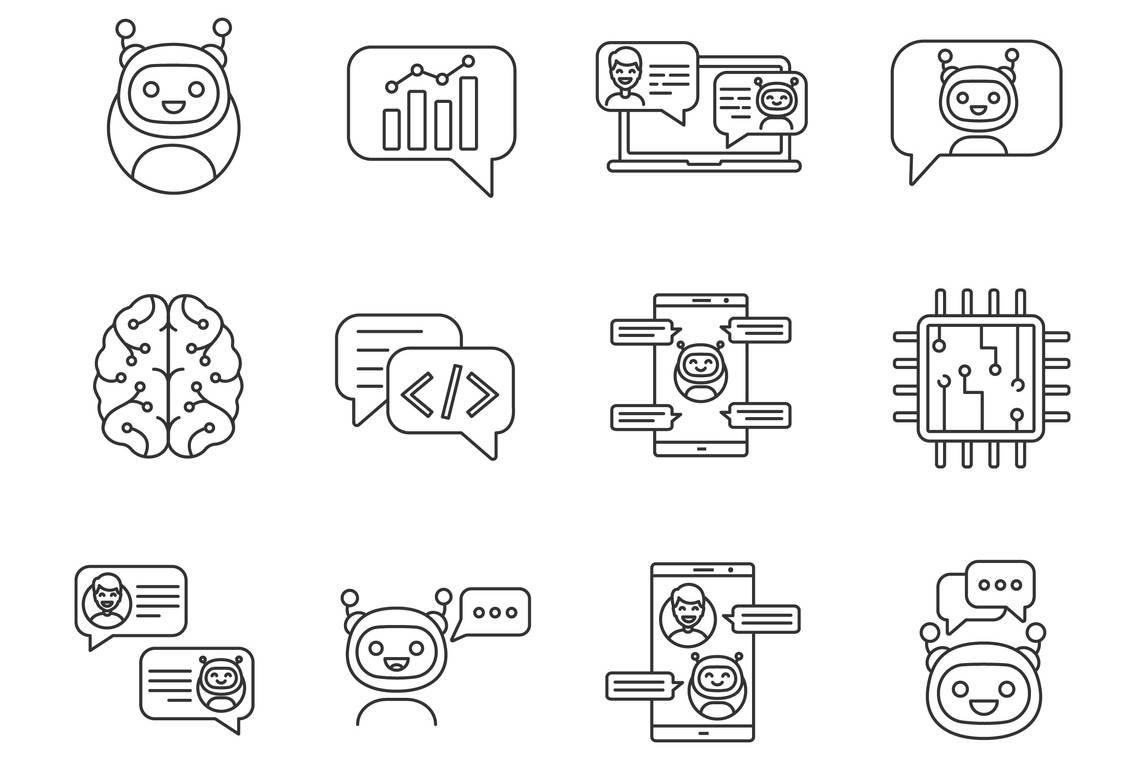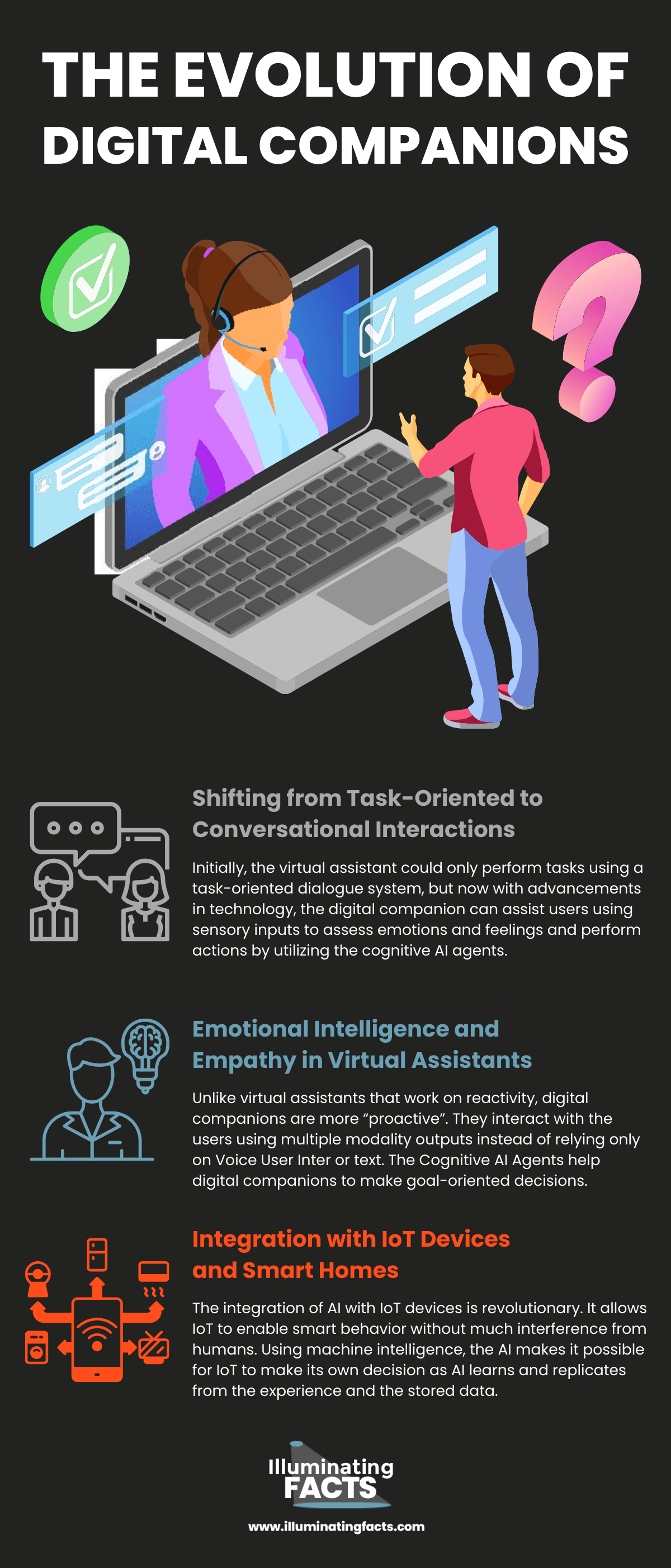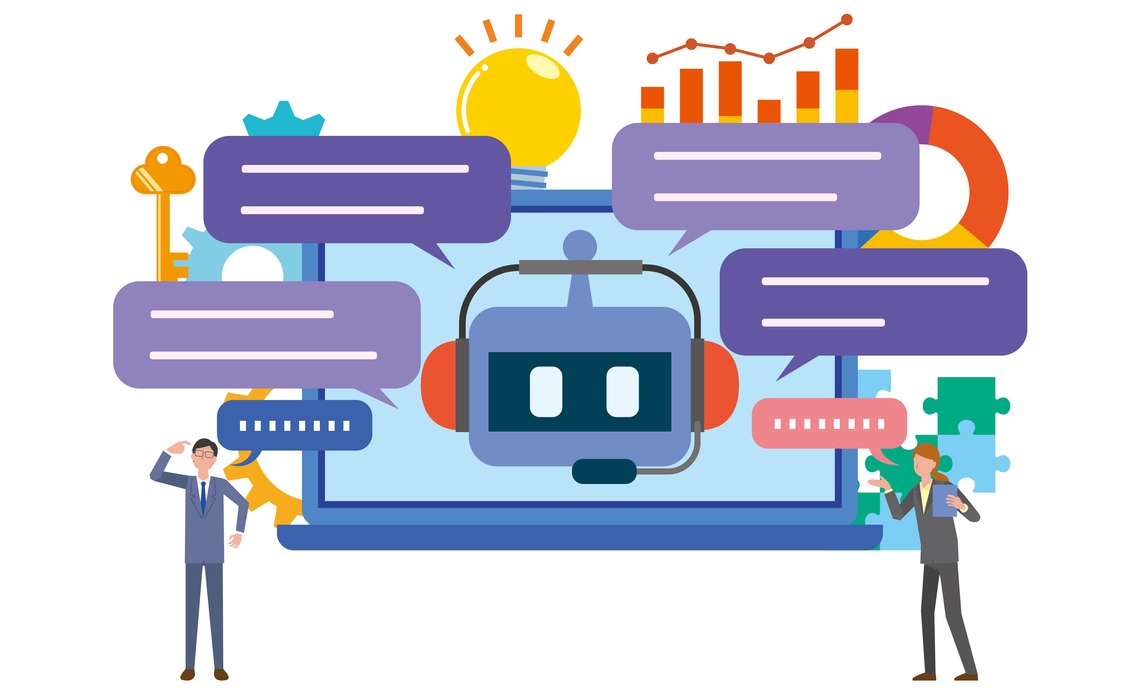From scheduling a meeting to reminding you of your loved ones’ birthdays, from playing your favorite playlist to dimming your room’s light, your digital assistant does all that and more. Long gone is the time when secretaries were required to make your official tasks simpler, now Siri for Apple users and Cortana for Microsoft users do all that without getting tired or forgetting themselves. [1] But what is this sorcery? Well, it is simple, with the boom in technology and Artificial intelligence, everything is at your fingertips now. These digital assistants or AI assistants have a thorough understanding of commands in natural languages and thus can easily perform the designated tasks.
Some interesting facts and figures regarding virtual assistants being used are listed below. [2]
- Did you know that 1.8 billion people were using AI virtual assistants by 2021?
- It was a $15.79 billion market by 2021 and this figure must have grown by now.
- Of all these users, almost 52% use AI assistants to listen to their favorite music or radio channel.
- Siri is the most favorite of all with 45% of the users using Siri as their AI assistant.
- It is estimated that by 2026, there will be 157.1 million Digital Assistant users in the USA alone. [3]
Be sure to check out our in-depth guide to Artificial Intelligence
Evolution of Virtual Assistants into Digital Companions
From simple tasks to complex emotional understanding, digital virtual assistants have come a long way all thanks to the revolution in machine learning and natural language processing. Interestingly, the idea of digital assistants sprouted from the use of smart speakers. The Amazon Echo released in 2014, made smart speakers a popular gadget in many homes. Its popularity can be judged by the fact that in 2022 one-third of the homes in the USA and UK used a virtual speaker at least one time a day. With people becoming more attached to their devices, it’s not surprising that digital virtual assistants have gradually become digital Companions. An example of this can be Woebat, the mental health app that uses AI to provide instant proven behavioral health solutions. [4]
Historical Development of Virtual Assistants: From Chatbots to Virtual Assistants
From chatbots to digital virtual assistants, one can see how technology, with time, has replaced human assistants, making tasks more efficient, and saving huge on labor costs. The timeline below can provide an overview of the evolution of virtual assistant technology. [5]
1966: A Computer Scientist, Joseph Weizenbaum, from MIT, built ELIZA for simulating communication with a psychotherapist.
1972: PARRY, a chatbot, was created by Kenneth Colby, a psychiatrist who intended to replicate a person suffering from paranoid schizophrenia.
The early 1990s: Personal Digital Assistants (PDAs) such as Palm Pilot and Apple Newton to save meetings, small notes, and contact details.
Late 1990s Early 2000s: Interactive Voice Response Systems was started to provide call center services.
2011-April: Siri was implemented by Apple that could recognize natural language and respond to commands.
2012-Google Now was introduced which made use of a machine learning algorithm to understand and forecast customized information and behaviors, providing traffic reports and weather forecasts.
2014: Microsoft introduced Cortana which was an amalgamation of voice recognition technology and AI technology.
2014: Amazon Echo released Alexa, the smart speaker cum virtual assistant, which can play music, operate smart home devices, and news updates.
2016: Google Home was launched that was run by Google Assistant providing a more user-friendly and interactive experience.
2020: Open AI GPT-3 powered AI language model for a human-like virtual assistant that can even write, draw and perform complicated tasks.
Key Technologies Enabling Digital Companions
In order to create your own virtual assistant, the four most important technologies that you need to learn are explained below. [6]
Natural Language Processing (NLP) Advancements
This speech recognition process is necessary to respond to the commands. AI has its own pre-trained samples but new data can make the process more advanced. While NLP assesses grammar and sentence structure, one needs additional technology to train a virtual assistant to understand and respond to the command. For that Natural Language Understanding (NLU) comes into play. It tries to analyze the query to provide more accuracy to the question. The Natural Language Generation then further processes it to deliver a more human-like conversation or response.
Speech Recognition and Synthesis Improvements
With Speech-to-text, the digital signals are generated through vibration, changing human speech to text. In the analog-to-digital converter, the sound is extracted, segmented, and compared with phonemes. The phonemes are then compared with words from natural languages and then converted to text. Text-to-speech works in the same manner, only this time the process is the opposite. For a virtual assistant, both of these technologies are used for efficient correspondence.
Machine Learning and Deep Learning Techniques
With the advancement of technology, now AI-assisted virtual assistants use deep learning algorithms to interpret and understand human-to-human conversation and the data of existing communication. [7] The data helps it predict and interpret with accuracy and thus perform the tasks with efficiency.
Contextual Understanding and Personalized Interactions
It is interesting how a digital virtual assistant is not a bot only who performs certain tasks but has become a companion to many. The interaction is not limited to official tasks but many interact with virtual assistants for tasks that are much more complex, like finding music for their type of mood. Now emotions, body language, and facial features are equally important for virtual assistants to understand and personalize things for the user.
For smooth working, now AI is employed with Emotion AI to understand non-verbal communication and behaviors. The technology observes the body language and emotions of how one reacts to any information. It uses machine learning and a computer vision algorithm that tracks facial movements with respect to emotions. These expressions are then compared with the existing data of images for virtual assistants to react with much more accuracy when interacting with users.
The Evolution of Digital Companions
The virtual assistant has evolved into a digital companion capable of gauging moods, assessing emotions, providing advice and emotional support, and acting as a teammate rather than an assistant. The digital companions are more like virtual humans interacting with the user. It is believed that these digital companions can even curb loneliness and be a valuable virtual family to elderlies. [8]
Shifting from Task-Oriented to Conversational Interactions
Initially, the virtual assistant could only perform tasks using a task-oriented dialogue system, but now with advancements in technology, the digital companion can assist users using sensory inputs to assess emotions and feelings and perform actions by utilizing the cognitive AI agents.
Emotional Intelligence and Empathy in Virtual Assistants
Unlike virtual assistants that work on reactivity, digital companions are more” proactive”. They interact with the users using multiple modality outputs instead of relying only on Voice User Inter or text. The Cognitive AI Agents help digital companions to make goal-oriented decisions, make them adopt proactive behavior by interacting with multi-modal inputs, and have the power to retain the data and information. Thus, their interaction with the users becomes more personalized and emotive. An example could be ElliQ, an app that works as a health companion for older people.
Integration with IoT Devices and Smart Homes
The integration of AI with IoT devices is revolutionary. It allows IoT to enable smart behavior without much interference from humans. Using machine intelligence, the AI makes it possible for IoT to make its own decision as AI learns and replicates from the experience and the stored data. [9] An example of this is how smartphones, devices, and appliances are operable using a smartphone. Now, with a click of a button, one can operate all tasks at home without being at home.
Impact on Various Industries
The AI virtual assistants are used by every sector be it a business or an entertainment industry, an education system, or a health service provider, AI is used in one way or the other. Some interesting facts related to a boom in AI assistant usage are stated below
- According to a survey 1/3rd of businesses have already integrated AI.
- 48% of marketing leaders believe that chatbots are changing the game for businesses by providing swift customer services.
- 54% of company leaders believe productivity has increased due to AI.
Customer Service and Support
AI chatbots have become imperative to businesses. 58% of B2B and 42% of B2C companies use chatbots for customer service already. 64% of chatbots provide 24-hrs customer service while 55% of these are smart enough to provide answers to easy queries and respond immediately. [10]
Healthcare and Mental Well-being
From a healing chatbot Woebot to an AI wearable Biobeats, now healthcare, mainly mental health, has become more accessible. These virtual assistants adapt to users’ behavior and provide them with immediate help or store their behavioral data for future assistance. [11] Similar AI assistants are Replika and Wysa, while Replika is your virtual friend that works through a “recurrent neural network” to behave like a human and provide you with comfort, Wysa helps you to overcome anxiety and depression [12]
Other sectors where AI assistants are often used are education and entertainment. Apps like Librarian AI, which suggests books as per your reading preferences in the past, and StudentMate which manages your homework assignments, education has become all the more fun and intuitive. [13] AI assistants like Aisera AI can be beneficial for both, the end user and the entertainment business as it provides the customers with swift customer service and provides the entertainment businesses with customer feedback, choices in entertainment, and preferences so industries can produce better content. [14]
Some Famous AI Assistants
Kuki Chatbot: Unlike Replika, Kuki is all about entertainment, if you are bored, install Kuki and make an entertaining bot-friend right away. [15]
Project PAI: If you want your digital clone that is your replica who has the same personality and behavioral traits then Project PAI is your thing; your virtual 3D avatar.
Ellie: The AI Friend in the video game “The Last of US”.
Conclusion
AI Assistant technology has come a long way and has become an integral part of our virtual ecosystem with such advancement, it is not wrong to assume that every one of us will have some reliance on AI assistants already; around 95% of smartphone users use AI bots/assistants for one thing or another. [16]
References
[1] What is virtual assistant (AI assistant)? – Definition from WhatIs.com. (2017, October 31). SearchCustomerExperience. https://www.techtarget.com/searchcustomerexperience/definition/virtual-assistant-AI-assistant
[2] The rise of virtual digital assistant usage – Go globe. (2018, April 27). GO-Globe. https://www.go-globe.com/the-rise-of-virtual-digital-assistants-usage-statistics-and-trends/
[3] U.S.; voice assistant users 2026. (2022, September 16). Statista. https://www.statista.com/statistics/1384575/voice-assistant-users-united-states/
[4] The evolution from virtual assistant to virtual companion. (n.d.). Licel. https://licelus.com/insights/the-evolution-from-virtual-assistant-to-virtual-companion
[5] Jovanovic, P. (2023, June 1). The history and evolution of virtual assistants. Tribulant Blog. https://tribulant.com/blog/software/the-history-and-evolution-of-virtual-assistants-from-simple-chatbots-to-todays-advanced-ai-powered-systems/
[6] Krasnokutsky, E. (2022, June 28). AI virtual assistant technology guide 2022. MobiDev. https://mobidev.biz/blog/ai-virtual-assistant-technology-guide
[7] Key technologies to drive artificial intelligence virtual assistants (IVAs) | Insights. (n.d.). Technology Solutions Provider – AI, RPA, and More | NITCO Inc. https://www.nitcoinc.com/blog/key-technologies-to-drive-artificial-intelligence-virtual-assistants/
[8] Hoke, N. (n.d.). Digital assistants vs digital companions: What’s the difference? Blog – Intuition Robotics. https://blog.intuitionrobotics.com/digital-assistants-vs-digital-companions-whats-the-difference
[9] Vinugayathri. (n.d.). AI and IoT blended – What it is and why it matters? Build Offshore Technology Team in India. In No Time. https://www.clariontech.com/blog/ai-and-iot-blended-what-it-is-and-why-it-matters
[10] Artificial intelligence statistics for 2023. (2023, April 28). SearchLogistics. https://www.searchlogistics.com/learn/statistics/artificial-intelligence-statistics/
[11] (n.d.). Forbes. https://www.forbes.com/sites/bernardmarr/2023/07/06/ai-in-mental-health-opportunities-and-challenges-in-developing-intelligent-digital-therapies/?sh=4852e2f15e10
[12] Web, B. (2023, July 3). Replika review : Pro or cons 2023 new updated. Artificial Intelligence Tools Review. https://aistoryland.com/replika/
[13] Education assistant AI tools – The complete list of all education AssistantAI tools only on AI tool guru. (n.d.). AI TOOL GURU – The best and largest AI tools directory. https://aitoolguru.com/categories/ai-education-assistant-ai-tools
[14] AI & automation for the media & entertainment industry. (2023, April 17). Aisera: Best Generative AI Platform For Enterprise. https://aisera.com/solutions/industries/media/
[15] Meet mitsuku A.k.a. Kuki. (n.d.). Free Chatbot maker | Chatbot for Website, WhatsApp | BotPenguin. https://botpenguin.com/mitsuku-kuki/
[16] Artificial intelligence statistics for 2023. (2023, April 28). SearchLogistics. https://www.searchlogistics.com/learn/statistics/artificial-intelligence-statistics/







